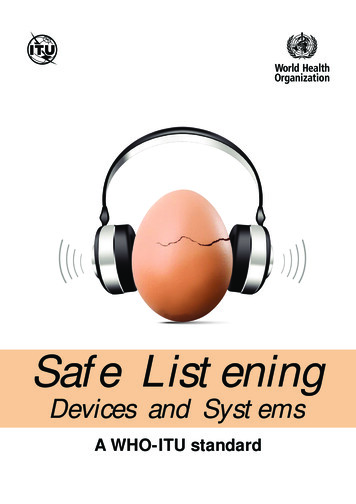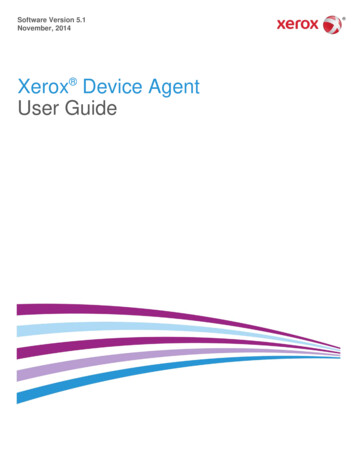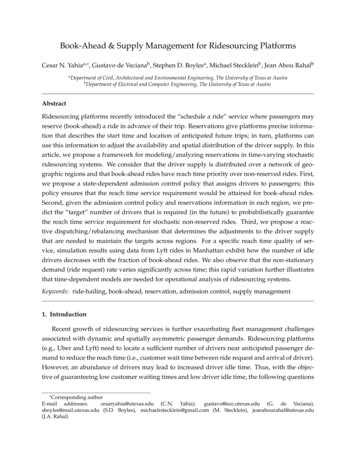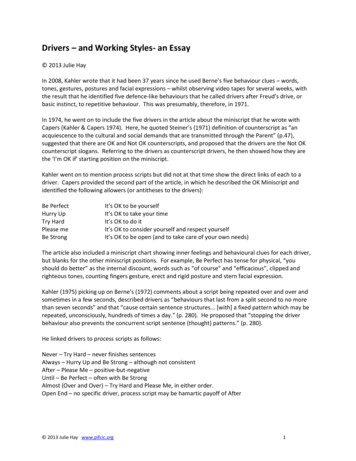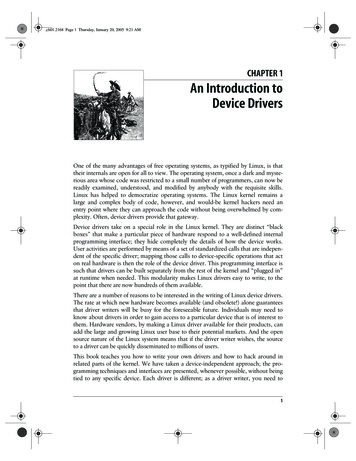
Transcription
,ch01.2168 Page 1 Thursday, January 20, 2005 9:21 AMChapter 1CHAPTER 1An Introduction toDevice DriversOne of the many advantages of free operating systems, as typified by Linux, is thattheir internals are open for all to view. The operating system, once a dark and mysterious area whose code was restricted to a small number of programmers, can now bereadily examined, understood, and modified by anybody with the requisite skills.Linux has helped to democratize operating systems. The Linux kernel remains alarge and complex body of code, however, and would-be kernel hackers need anentry point where they can approach the code without being overwhelmed by complexity. Often, device drivers provide that gateway.Device drivers take on a special role in the Linux kernel. They are distinct “blackboxes” that make a particular piece of hardware respond to a well-defined internalprogramming interface; they hide completely the details of how the device works.User activities are performed by means of a set of standardized calls that are independent of the specific driver; mapping those calls to device-specific operations that acton real hardware is then the role of the device driver. This programming interface issuch that drivers can be built separately from the rest of the kernel and “plugged in”at runtime when needed. This modularity makes Linux drivers easy to write, to thepoint that there are now hundreds of them available.There are a number of reasons to be interested in the writing of Linux device drivers.The rate at which new hardware becomes available (and obsolete!) alone guaranteesthat driver writers will be busy for the foreseeable future. Individuals may need toknow about drivers in order to gain access to a particular device that is of interest tothem. Hardware vendors, by making a Linux driver available for their products, canadd the large and growing Linux user base to their potential markets. And the opensource nature of the Linux system means that if the driver writer wishes, the sourceto a driver can be quickly disseminated to millions of users.This book teaches you how to write your own drivers and how to hack around inrelated parts of the kernel. We have taken a device-independent approach; the programming techniques and interfaces are presented, whenever possible, without beingtied to any specific device. Each driver is different; as a driver writer, you need to1This is the Title of the Book, eMatter EditionCopyright 2005 O’Reilly & Associates, Inc. All rights reserved.
,ch01.2168 Page 2 Thursday, January 20, 2005 9:21 AMunderstand your specific device well. But most of the principles and basic techniques are the same for all drivers. This book cannot teach you about your device,but it gives you a handle on the background you need to make your device work.As you learn to write drivers, you find out a lot about the Linux kernel in general;this may help you understand how your machine works and why things aren’talways as fast as you expect or don’t do quite what you want. We introduce newideas gradually, starting off with very simple drivers and building on them; every newconcept is accompanied by sample code that doesn’t need special hardware to betested.This chapter doesn’t actually get into writing code. However, we introduce somebackground concepts about the Linux kernel that you’ll be glad you know later,when we do launch into programming.The Role of the Device DriverAs a programmer, you are able to make your own choices about your driver, andchoose an acceptable trade-off between the programming time required and the flexibility of the result. Though it may appear strange to say that a driver is “flexible,” welike this word because it emphasizes that the role of a device driver is providingmechanism, not policy.The distinction between mechanism and policy is one of the best ideas behind theUnix design. Most programming problems can indeed be split into two parts: “whatcapabilities are to be provided” (the mechanism) and “how those capabilities can beused” (the policy). If the two issues are addressed by different parts of the program,or even by different programs altogether, the software package is much easier todevelop and to adapt to particular needs.For example, Unix management of the graphic display is split between the X server,which knows the hardware and offers a unified interface to user programs, and thewindow and session managers, which implement a particular policy without knowing anything about the hardware. People can use the same window manager on different hardware, and different users can run different configurations on the sameworkstation. Even completely different desktop environments, such as KDE andGNOME, can coexist on the same system. Another example is the layered structureof TCP/IP networking: the operating system offers the socket abstraction, whichimplements no policy regarding the data to be transferred, while different servers arein charge of the services (and their associated policies). Moreover, a server like ftpdprovides the file transfer mechanism, while users can use whatever client they prefer;both command-line and graphic clients exist, and anyone can write a new user interface to transfer files.Where drivers are concerned, the same separation of mechanism and policy applies.The floppy driver is policy free—its role is only to show the diskette as a continuous2 Chapter 1: An Introduction to Device DriversThis is the Title of the Book, eMatter EditionCopyright 2005 O’Reilly & Associates, Inc. All rights reserved.
,ch01.2168 Page 3 Thursday, January 20, 2005 9:21 AMarray of data blocks. Higher levels of the system provide policies, such as who mayaccess the floppy drive, whether the drive is accessed directly or via a filesystem, andwhether users may mount filesystems on the drive. Since different environments usually need to use hardware in different ways, it’s important to be as policy free aspossible.When writing drivers, a programmer should pay particular attention to this fundamental concept: write kernel code to access the hardware, but don’t force particularpolicies on the user, since different users have different needs. The driver should dealwith making the hardware available, leaving all the issues about how to use the hardware to the applications. A driver, then, is flexible if it offers access to the hardwarecapabilities without adding constraints. Sometimes, however, some policy decisionsmust be made. For example, a digital I/O driver may only offer byte-wide access tothe hardware in order to avoid the extra code needed to handle individual bits.You can also look at your driver from a different perspective: it is a software layerthat lies between the applications and the actual device. This privileged role of thedriver allows the driver programmer to choose exactly how the device should appear:different drivers can offer different capabilities, even for the same device. The actualdriver design should be a balance between many different considerations. Forinstance, a single device may be used concurrently by different programs, and thedriver programmer has complete freedom to determine how to handle concurrency.You could implement memory mapping on the device independently of its hardwarecapabilities, or you could provide a user library to help application programmersimplement new policies on top of the available primitives, and so forth. One majorconsideration is the trade-off between the desire to present the user with as manyoptions as possible and the time you have to write the driver, as well as the need tokeep things simple so that errors don’t creep in.Policy-free drivers have a number of typical characteristics. These include support forboth synchronous and asynchronous operation, the ability to be opened multipletimes, the ability to exploit the full capabilities of the hardware, and the lack of software layers to “simplify things” or provide policy-related operations. Drivers of thissort not only work better for their end users, but also turn out to be easier to writeand maintain as well. Being policy-free is actually a common target for softwaredesigners.Many device drivers, indeed, are released together with user programs to help withconfiguration and access to the target device. Those programs can range from simpleutilities to complete graphical applications. Examples include the tunelp program,which adjusts how the parallel port printer driver operates, and the graphical cardctlutility that is part of the PCMCIA driver package. Often a client library is provided aswell, which provides capabilities that do not need to be implemented as part of thedriver itself.The Role of the Device Driver This is the Title of the Book, eMatter EditionCopyright 2005 O’Reilly & Associates, Inc. All rights reserved.3
,ch01.2168 Page 4 Thursday, January 20, 2005 9:21 AMThe scope of this book is the kernel, so we try not to deal with policy issues or withapplication programs or support libraries. Sometimes we talk about different policies and how to support them, but we won’t go into much detail about programsusing the device or the policies they enforce. You should understand, however, thatuser programs are an integral part of a software package and that even policy-freepackages are distributed with configuration files that apply a default behavior to theunderlying mechanisms.Splitting the KernelIn a Unix system, several concurrent processes attend to different tasks. Each processasks for system resources, be it computing power, memory, network connectivity, orsome other resource. The kernel is the big chunk of executable code in charge of handling all such requests. Although the distinction between the different kernel tasksisn’t always clearly marked, the kernel’s role can be split (as shown in Figure 1-1)into the following parts:Process managementThe kernel is in charge of creating and destroying processes and handling theirconnection to the outside world (input and output). Communication among different processes (through signals, pipes, or interprocess communication primitives) is basic to the overall system functionality and is also handled by thekernel. In addition, the scheduler, which controls how processes share the CPU,is part of process management. More generally, the kernel’s process management activity implements the abstraction of several processes on top of a singleCPU or a few of them.Memory managementThe computer’s memory is a major resource, and the policy used to deal with itis a critical one for system performance. The kernel builds up a virtual addressing space for any and all processes on top of the limited available resources. Thedifferent parts of the kernel interact with the memory-management subsystemthrough a set of function calls, ranging from the simple malloc/free pair to muchmore complex functionalities.FilesystemsUnix is heavily based on the filesystem concept; almost everything in Unix canbe treated as a file. The kernel builds a structured filesystem on top of unstructured hardware, and the resulting file abstraction is heavily used throughout thewhole system. In addition, Linux supports multiple filesystem types, that is, different ways of organizing data on the physical medium. For example, disks maybe formatted with the Linux-standard ext3 filesystem, the commonly used FATfilesystem or several others.4 Chapter 1: An Introduction to Device DriversThis is the Title of the Book, eMatter EditionCopyright 2005 O’Reilly & Associates, Inc. All rights reserved.
,ch01.2168 Page 5 Thursday, January 20, 2005 9:21 AMDevice controlAlmost every system operation eventually maps to a physical device. With theexception of the processor, memory, and a very few other entities, any and alldevice control operations are performed by code that is specific to the devicebeing addressed. That code is called a device driver. The kernel must haveembedded in it a device driver for every peripheral present on a system, from thehard drive to the keyboard and the tape drive. This aspect of the kernel’s functions is our primary interest in this book.NetworkingNetworking must be managed by the operating system, because most networkoperations are not specific to a process: incoming packets are asynchronousevents. The packets must be collected, identified, and dispatched before a process takes care of them. The system is in charge of delivering data packets acrossprogram and network interfaces, and it must control the execution of programsaccording to their network activity. Additionally, all the routing and address resolution issues are implemented within the kernel.Loadable ModulesOne of the good features of Linux is the ability to extend at runtime the set of features offered by the kernel. This means that you can add functionality to the kernel(and remove functionality as well) while the system is up and running.Each piece of code that can be added to the kernel at runtime is called a module. TheLinux kernel offers support for quite a few different types (or classes) of modules,including, but not limited to, device drivers. Each module is made up of object code(not linked into a complete executable) that can be dynamically linked to the running kernel by the insmod program and can be unlinked by the rmmod program.Figure 1-1 identifies different classes of modules in charge of specific tasks—a module is said to belong to a specific class according to the functionality it offers. Theplacement of modules in Figure 1-1 covers the most important classes, but is far fromcomplete because more and more functionality in Linux is being modularized.Classes of Devices and ModulesThe Linux way of looking at devices distinguishes between three fundamental devicetypes. Each module usually implements one of these types, and thus is classifiable as achar module, a block module, or a network module. This division of modules into different types, or classes, is not a rigid one; the programmer can choose to build hugemodules implementing different drivers in a single chunk of code. Good programmers, nonetheless, usually create a different module for each new functionality theyimplement, because decomposition is a key element of scalability and extendability.Classes of Devices and Modules This is the Title of the Book, eMatter EditionCopyright 2005 O’Reilly & Associates, Inc. All rights reserved.5
,ch01.2168 Page 6 Thursday, January 20, 2005 9:21 AMThe System Call VirtualmemoryFiles and dirs:the VFSTtys &device le ubsystemsFeaturesimplementedSoftwaresupportBlock devicesIF driversHardwareCPUMemoryDisks & CDsConsoles,etc.Networkinterfacesfeatures implemented as modulesFigure 1-1. A split view of the kernelThe three classes are:Character devicesA character (char) device is one that can be accessed as a stream of bytes (like afile); a char driver is in charge of implementing this behavior. Such a driver usually implements at least the open, close, read, and write system calls. The textconsole (/dev/console) and the serial ports (/dev/ttyS0 and friends) are examplesof char devices, as they are well represented by the stream abstraction. Chardevices are accessed by means of filesystem nodes, such as /dev/tty1 and /dev/lp0.The only relevant difference between a char device and a regular file is that youcan always move back and forth in the regular file, whereas most char devicesare just data channels, which you can only access sequentially. There exist,nonetheless, char devices that look like data areas, and you can move back andforth in them; for instance, this usually applies to frame grabbers, where theapplications can access the whole acquired image using mmap or lseek.6 Chapter 1: An Introduction to Device DriversThis is the Title of the Book, eMatter EditionCopyright 2005 O’Reilly & Associates, Inc. All rights reserved.
,ch01.2168 Page 7 Thursday, January 20, 2005 9:21 AMBlock devicesLike char devices, block devices are accessed by filesystem nodes in the /devdirectory. A block device is a device (e.g., a disk) that can host a filesystem. Inmost Unix systems, a block device can only handle I/O operations that transferone or more whole blocks, which are usually 512 bytes (or a larger power oftwo) bytes in length. Linux, instead, allows the application to read and write ablock device like a char device—it permits the transfer of any number of bytes ata time. As a result, block and char devices differ only in the way data is managedinternally by the kernel, and thus in the kernel/driver software interface. Like achar device, each block device is accessed through a filesystem node, and the difference between them is transparent to the user. Block drivers have a completelydifferent interface to the kernel than char drivers.Network interfacesAny network transaction is made through an interface, that is, a device that isable to exchange data with other hosts. Usually, an interface is a hardwaredevice, but it might also be a pure software device, like the loopback interface. Anetwork interface is in charge of sending and receiving data packets, driven bythe network subsystem of the kernel, without knowing how individual transactions map to the actual packets being transmitted. Many network connections(especially those using TCP) are stream-oriented, but network devices are, usually, designed around the transmission and receipt of packets. A network driverknows nothing about individual connections; it only handles packets.Not being a stream-oriented device, a network interface isn’t easily mapped to anode in the filesystem, as /dev/tty1 is. The Unix way to provide access to interfaces is still by assigning a unique name to them (such as eth0), but that namedoesn’t have a corresponding entry in the filesystem. Communication betweenthe kernel and a network device driver is completely different from that usedwith char and block drivers. Instead of read and write, the kernel calls functionsrelated to packet transmission.There are other ways of classifying driver modules that are orthogonal to the abovedevice types. In general, some types of drivers work with additional layers of kernelsupport functions for a given type of device. For example, one can talk of universalserial bus (USB) modules, serial modules, SCSI modules, and so on. Every USBdevice is driven by a USB module that works with the USB subsystem, but the deviceitself shows up in the system as a char device (a USB serial port, say), a block device(a USB memory card reader), or a network device (a USB Ethernet interface).Other classes of device drivers have been added to the kernel in recent times, including FireWire drivers and I2O drivers. In the same way that they handled USB andSCSI drivers, kernel developers collected class-wide features and exported them todriver implementers to avoid duplicating work and bugs, thus simplifying andstrengthening the process of writing such drivers.Classes of Devices and Modules This is the Title of the Book, eMatter EditionCopyright 2005 O’Reilly & Associates, Inc. All rights reserved.7
,ch01.2168 Page 8 Thursday, January 20, 2005 9:21 AMIn addition to device drivers, other functionalities, both hardware and software, aremodularized in the kernel. One common example is filesystems. A filesystem typedetermines how information is organized on a block device in order to represent atree of directories and files. Such an entity is not a device driver, in that there’s noexplicit device associated with the way the information is laid down; the filesystemtype is instead a software driver, because it maps the low-level data structures tohigh-level data structures. It is the filesystem that determines how long a filenamecan be and what information about each file is stored in a directory entry. The filesystem module must implement the lowest level of the system calls that access directories and files, by mapping filenames and paths (as well as other information, suchas access modes) to data structures stored in data blocks. Such an interface is completely independent of the actual data transfer to and from the disk (or othermedium), which is accomplished by a block device driver.If you think of how strongly a Unix system depends on the underlying filesystem,you’ll realize that such a software concept is vital to system operation. The ability todecode filesystem information stays at the lowest level of the kernel hierarchy and isof utmost importance; even if you write a block driver for your new CD-ROM, it isuseless if you are not able to run ls or cp on the data it hosts. Linux supports the concept of a filesystem module, whose software interface declares the different operations that can be performed on a filesystem inode, directory, file, and superblock. It’squite unusual for a programmer to actually need to write a filesystem module,because the official kernel already includes code for the most important filesystemtypes.Security IssuesSecurity is an increasingly important concern in modern times. We will discuss security-related issues as they come up throughout the book. There are a few general concepts, however, that are worth mentioning now.Any security check in the system is enforced by kernel code. If the kernel has security holes, then the system as a whole has holes. In the official kernel distribution,only an authorized user can load modules; the system call init module checks if theinvoking process is authorized to load a module into the kernel. Thus, when running an official kernel, only the superuser,* or an intruder who has succeeded inbecoming privileged, can exploit the power of privileged code.When possible, driver writers should avoid encoding security policy in their code.Security is a policy issue that is often best handled at higher levels within the kernel,under the control of the system administrator. There are always exceptions, however.* Technically, only somebody with the CAP SYS MODULE capability can perform this operation. We discusscapabilities in Chapter 6.8 Chapter 1: An Introduction to Device DriversThis is the Title of the Book, eMatter EditionCopyright 2005 O’Reilly & Associates, Inc. All rights reserved.
,ch01.2168 Page 9 Thursday, January 20, 2005 9:21 AMAs a device driver writer, you should be aware of situations in which some types ofdevice access could adversely affect the system as a whole and should provide adequate controls. For example, device operations that affect global resources (such assetting an interrupt line), which could damage the hardware (loading firmware, forexample), or that could affect other users (such as setting a default block size on atape drive), are usually only available to sufficiently privileged users, and this checkmust be made in the driver itself.Driver writers must also be careful, of course, to avoid introducing security bugs.The C programming language makes it easy to make several types of errors. Manycurrent security problems are created, for example, by buffer overrun errors, in whichthe programmer forgets to check how much data is written to a buffer, and data endsup written beyond the end of the buffer, thus overwriting unrelated data. Such errorscan compromise the entire system and must be avoided. Fortunately, avoiding theseerrors is usually relatively easy in the device driver context, in which the interface tothe user is narrowly defined and highly controlled.Some other general security ideas are worth keeping in mind. Any input receivedfrom user processes should be treated with great suspicion; never trust it unless youcan verify it. Be careful with uninitialized memory; any memory obtained from thekernel should be zeroed or otherwise initialized before being made available to a userprocess or device. Otherwise, information leakage (disclosure of data, passwords,etc.) could result. If your device interprets data sent to it, be sure the user cannotsend anything that could compromise the system. Finally, think about the possibleeffect of device operations; if there are specific operations (e.g., reloading the firmware on an adapter board or formatting a disk) that could affect the system, thoseoperations should almost certainly be restricted to privileged users.Be careful, also, when receiving software from third parties, especially when the kernel is concerned: because everybody has access to the source code, everybody canbreak and recompile things. Although you can usually trust precompiled kernelsfound in your distribution, you should avoid running kernels compiled by anuntrusted friend—if you wouldn’t run a precompiled binary as root, then you’d better not run a precompiled kernel. For example, a maliciously modified kernel couldallow anyone to load a module, thus opening an unexpected back door via init module.Note that the Linux kernel can be compiled to have no module support whatsoever,thus closing any module-related security holes. In this case, of course, all neededdrivers must be built directly into the kernel itself. It is also possible, with 2.2 andlater kernels, to disable the loading of kernel modules after system boot via the capability mechanism.Security Issues This is the Title of the Book, eMatter EditionCopyright 2005 O’Reilly & Associates, Inc. All rights reserved.9
,ch01.2168 Page 10 Thursday, January 20, 2005 9:21 AMVersion NumberingBefore digging into programming, we should comment on the version numberingscheme used in Linux and which versions are covered by this book.First of all, note that every software package used in a Linux system has its ownrelease number, and there are often interdependencies across them: you need a particular version of one package to run a particular version of another package. Thecreators of Linux distributions usually handle the messy problem of matching packages, and the user who installs from a prepackaged distribution doesn’t need to dealwith version numbers. Those who replace and upgrade system software, on the otherhand, are on their own in this regard. Fortunately, almost all modern distributionssupport the upgrade of single packages by checking interpackage dependencies; thedistribution’s package manager generally does not allow an upgrade until the dependencies are satisfied.To run the examples we introduce during the discussion, you won’t need particularversions of any tool beyond what the 2.6 kernel requires; any recent Linux distribution can be used to run our examples. We won’t detail specific requirements,because the file Documentation/Changes in your kernel sources is the best source ofsuch information if you experience any problems.As far as the kernel is concerned, the even-numbered kernel versions (i.e., 2.6.x) arethe stable ones that are intended for general distribution. The odd versions (such as2.7.x), on the contrary, are development snapshots and are quite ephemeral; the latest of them represents the current status of development, but becomes obsolete in afew days or so.This book covers Version 2.6 of the kernel. Our focus has been to show all the features available to device driver writers in 2.6.10, the current version at the time weare writing. This edition of the book does not cover prior versions of the kernel. Forthose of you who are interested, the second edition covered Versions 2.0 through 2.4in detail. That edition is still available online at http://lwn.net/Kernel/LDD2/.Kernel programmers should be aware that the development process changed with 2.6.The 2.6 series is now accepting changes that previously would have been consideredtoo large for a “stable” kernel. Among other things, that means that internal kernelprogramming interfaces can change, thus potentially obsoleting parts of this book;for this reason, the sample code accompanying the text is known to work with 2.6.10,but some modules don’t compile under earlier versions. Programmers wanting tokeep up with kernel programming changes are encouraged to join the mailing listsand to make use of the web sites listed in the bibliography. There is also a web pagemaintained at http://lwn.net/Articles/2.6-kernel-api/, which contains informationabout API changes that have happened since this book was published.10 Chapter 1: An Introduction to Device DriversThis is the Title of the Book, eMatter EditionCopyright 2005 O’Reilly & Associates, Inc. All rights reserved.
,ch01.2168 Page 11 Thursday, January 20, 2005 9:21 AMThis text doesn’t talk specifically about odd-numbered kernel versions. General usersnever have a reason to run development kernels. Developers experimenting with newfeatures, however, want to be running the latest development release. They usuallykeep upgrading to the most recent version to pick up bug fixes and new implementations of features. Note, however, that there’s no guarantee on experimental kernels,*and nobody helps you if you have problems due to a bug in a noncurrent odd-numbered kernel. Those who run odd-numbered versions of the kernel are usually skilledenough to dig in the code without the need for a textbook, which is another reasonwhy we don’t talk about development kernels here.Another feature of Linux is that it is a platform-independent operating system, notjust “a Unix clone for PC clones” anymore: it currently supports some 20 architectures. This book is platform independent as far as possible, and all the code sampleshave been tested on at least the x86 and x86-64 platforms. Because the code has beentested on both 32-bit and 64-bit processors, it should compile and run on all otherplatforms. As you might expect, the code samples that rely on particular hardwaredon’t work on all the supported platforms, but this is always stated in the sourcecode.License TermsLinux is licensed under Version
This is the Title of the Book, eMatter Edition Copyright 2005 O'Reilly & Associates, Inc. All rights reserved. 2 Chapter 1: An Introduction to Device Drivers


